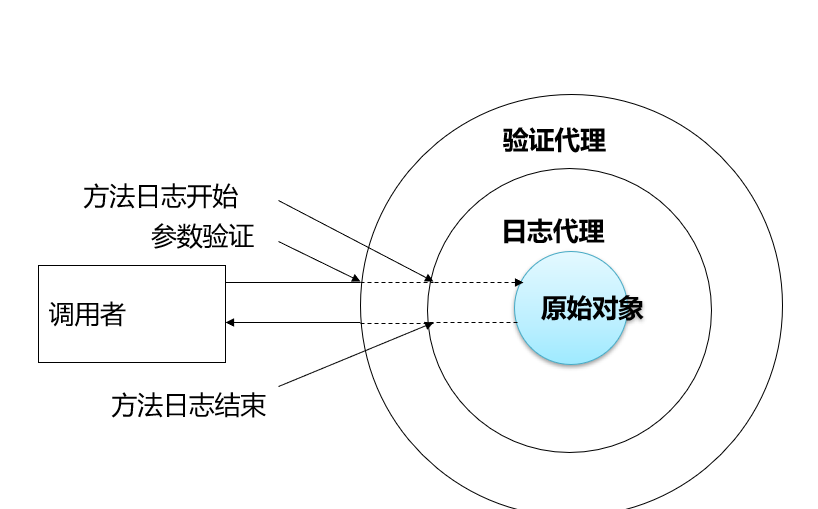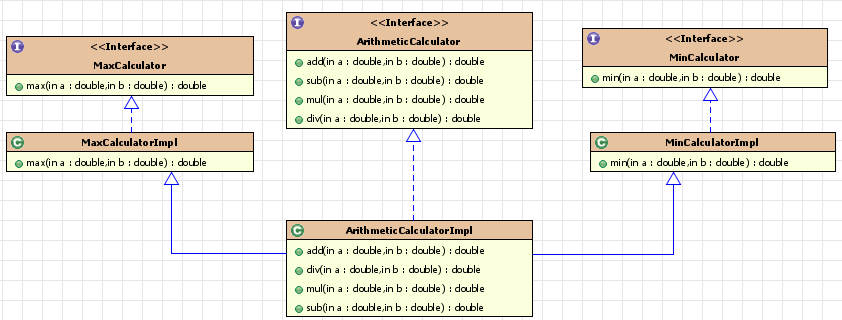Spring系列__04AOP简介
今天来介绍一下AOP。AOP,中文常被翻译为“面向切面编程”,其作为OOP的扩展,其思想除了在Spring中得到了应用,也是不错的设计方法。通常情况下,一个软件系统,除了正常的业务逻辑代码,往往还有一些功能性的代码,比如:记录日志、数据校验等等。最原始的办法就是直接在你的业务逻辑代码中编写这些功能性代码,但是,这样除了当时开发的时候比较方便以外;代码的阅读性、可维护性都会大大降低。而且,当你需要频繁使用一个功能的时候(比如记录日志),你还需要重复编写。而使用AOP的好处,简单来说就是,它能把这种重复性的功能代码抽离出来,在需要的时候,通过动态代理技术,在不修改源代码的情况下提供增强性功能。 优势:
- 减少重复代码
- 提高开发效率
- 代码更加整洁,提高了可维护性 说了这么多,简单演示一下,我们假定现在要实现一个账户转账的功能,这里面会涉及到一些事务的控制,从代码的合理性角度出发,我们将其放在service层。
@Getter
@Setter
@NoArgsConstructor
@AllArgsConstructor
@ToString
@EqualsAndHashCode
public class Account implements Serializable {
private Integer id;
private String name;
private Float money;
}
public interface AccountDao {
/**
* 查询所有
* @return
*/
List<Account> findAllAccount();
/**
* 查询一个
* @return
*/
Account findAccountById(Integer accountId);
/**
* 保存
* @param account
*/
void saveAccount(Account account);
/**
* 更新
* @param account
*/
void updateAccount(Account account);
/**
* 删除
* @param acccountId
*/
void deleteAccount(Integer acccountId);
/**
* 根据名称查询账户
* @param accountName
* @return 如果有唯一的一个结果就返回,如果没有结果就返回null
* 如果结果集超过一个就抛异常
*/
Account findAccountByName(String accountName);
}
public class AccountServiceImpl_OLD implements AccountService {
private AccountDao accountDao;
private TransactionManager txManager;
public void setTxManager(TransactionManager txManager) {
this.txManager = txManager;
}
public void setAccountDao(AccountDao accountDao) {
this.accountDao = accountDao;
}
@Override
public List<Account> findAllAccount() {
try {
//1.开启事务
txManager.beginTransaction();
//2.执行操作
List<Account> accounts = accountDao.findAllAccount();
//3.提交事务
txManager.commit();
//4.返回结果
return accounts;
}catch (Exception e){
//5.回滚操作
txManager.rollback();
throw new RuntimeException(e);
}finally {
//6.释放连接
txManager.release();
}
}
@Override
public Account findAccountById(Integer accountId) {
try {
//1.开启事务
txManager.beginTransaction();
//2.执行操作
Account account = accountDao.findAccountById(accountId);
//3.提交事务
txManager.commit();
//4.返回结果
return account;
}catch (Exception e){
//5.回滚操作
txManager.rollback();
throw new RuntimeException(e);
}finally {
//6.释放连接
txManager.release();
}
}
@Override
public void saveAccount(Account account) {
try {
//1.开启事务
txManager.beginTransaction();
//2.执行操作
accountDao.saveAccount(account);
//3.提交事务
txManager.commit();
}catch (Exception e){
//4.回滚操作
txManager.rollback();
}finally {
//5.释放连接
txManager.release();
}
}
@Override
public void updateAccount(Account account) {
try {
//1.开启事务
txManager.beginTransaction();
//2.执行操作
accountDao.updateAccount(account);
//3.提交事务
txManager.commit();
}catch (Exception e){
//4.回滚操作
txManager.rollback();
}finally {
//5.释放连接
txManager.release();
}
}
@Override
public void deleteAccount(Integer acccountId) {
try {
//1.开启事务
txManager.beginTransaction();
//2.执行操作
accountDao.deleteAccount(acccountId);
//3.提交事务
txManager.commit();
}catch (Exception e){
//4.回滚操作
txManager.rollback();
}finally {
//5.释放连接
txManager.release();
}
}
@Override
public void transfer(String sourceName, String targetName, Float money) {
try {
//1.开启事务
txManager.beginTransaction();
//2.执行操作
//2.1根据名称查询转出账户
Account source = accountDao.findAccountByName(sourceName);
//2.2根据名称查询转入账户
Account target = accountDao.findAccountByName(targetName);
//2.3转出账户减钱
source.setMoney(source.getMoney()-money);
//2.4转入账户加钱
target.setMoney(target.getMoney()+money);
//2.5更新转出账户
accountDao.updateAccount(source);
int i=1/0;
//2.6更新转入账户
accountDao.updateAccount(target);
//3.提交事务
txManager.commit();
}catch (Exception e){
//4.回滚操作
txManager.rollback();
e.printStackTrace();
}finally {
//5.释放连接
txManager.release();
}
}
复制代码
在这里,我们看见了很恶心的代码:大量重复性的记录日志的代码,而且,当你更改的时候,你发现并不方便。后续我们会对这个代码进行改写。
AOP的实现方式
AOP通过动态代理的来实现。
动态代理简介
在这里先简单介绍一下动态代理:使用一个代理将对象包装起来, 然后用该代理对象取代原始对象.。任何对原始对象的调用都要通过代理. 代理对象决定是否以及何时将方法调用转到原始对象上。其调用过程如下图所示:

特点:
- 字节码随用随创建,随用随加载。
- 它与静态代理的区别也在于此。因为静态代理是字节码一上来就创建好,并完成加载。
- 装饰者模式就是静态代理的一种体现。
动态代理有两种形式
- 基于接口的动态代理 提供者: JDK 官方的 Proxy 类。 要求:被代理类最少实现一个接口
- 基于子类的动态代理 提供者:第三方的 CGLib,如果报 asmxxxx 异常,需要导入 asm.jar。 要求:被代理类不能用 final 修饰的类(最终类)。 下面结合示例来解释一下这两种动态代理的实现方式: 笔者最近更换了一台新的电脑,就以买电脑来举个例子吧。现在大家买电脑,已经很少去实体店了,多半是通过电商渠道。不管是什么,都是从中间商来买,这一行为,在无形中就体现了代理模式的思想。 电脑生产商最开始的时候,除了生产和组装电脑,同时还可以将电脑出售给消费者或者经销商(代理商),而他对顾客来说,需要完成两种服务:销售商品和售后服务。当行业发展到一定阶段,电脑生产商不断增多,人们就会制定一些行业规范来让大家共同遵守(也就是抽象出来的接口)。而且,电脑生产商为了节约成本,不再提供直接和消费者销售的服务,我们消费者也因此只能从代理商那里购买新的电脑。这便是典型的代理模式。
使用 JDK 官方的 Proxy 类创建代理对象
public interface IProducer {
public void saleProduct(float money);
public void afterService(float money);
}
public class Producer implements IProducer {
@Override
public void saleProduct(float money) {
System.out.println("销售产品,并拿到钱:" + money);
}
@Override
public void afterService(float money) {
System.out.println("提供售后服务,并拿到钱:" + money);
}
}
//消费者
public class Client {
public static void main(String[] args) {
final Producer producer = new Producer();
/**
* 如何创建代理对象:
* 使用Proxy类中的newProxyInstance方法
* 创建代理对象的要求:
* 被代理类最少实现一个接口,如果没有则不能使用
* newProxyInstance方法的参数:
* ClassLoader:类加载器
* 它是用于加载代理对象字节码的。和被代理对象使用相同的类加载器。固定写法。
* Class[]:字节码数组
* 它是用于让代理对象和被代理对象有相同方法。固定写法。
* InvocationHandler:用于提供增强的代码
* 它是让我们写如何代理。我们一般都是些一个该接口的实现类,通常情况下都是匿名内部类,但不是必须的。
* 此接口的实现类都是谁用谁写。
*/
IProducer proxyProducer = (IProducer) Proxy.newProxyInstance(producer.getClass().getClassLoader(),
producer.getClass().getInterfaces(), new InvocationHandler() {
/**
* 作用:执行被代理对象的任何接口方法都会经过该方法
* 方法参数的含义
* @param proxy 代理对象的引用
* @param method 当前执行的方法
* @param args 当前执行方法所需的参数
* @return 和被代理对象方法有相同的返回值
* @throws Throwable
*/
@Override
public Object invoke(Object proxy, Method method, Object[] args) throws Throwable {
//提供增强的代码
Object returnValue = null;
//1.获取方法执行的参数
Float money = (Float)args[0];
//2.判断当前方法是不是销售,如果是的话,打八折
if("saleProduct".equals(method.getName())) {
returnValue = method.invoke(producer, money*0.8f);
}
return returnValue;
}
});
proxyProducer.saleProduct(10000f);
}
}
复制代码
使用jdk提供的Proxy来创建代理对象的时候,要求别代理对象至少要实现一个接口,代理类需要实现同样的接口并由同一类加载器加载。如果没有这样,就不能使用这种方式了。其他具体内容,请参考官方文档。
cglib方式来实现动态代理
其实,说AOP是OOP的延伸,还是很容易证明的:jdk提供动态代理的方式是实现接口,而cglib的实现方式就是利用了OOP的继承。原理大同小异,主要区别就是不用实现接口而是改用继承,也因此具备继承的限制:被代理的类不能是被final修饰。
public class Client {
public static void main(String[] args) {
final Producer producer = new Producer();
/**
* create方法的参数:
* Class:字节码
* 它是用于指定被代理对象的字节码。
*
* Callback:用于提供增强的代码
* 它是让我们写如何代理。我们一般都是些一个该接口的实现类,通常情况下都是匿名内部类,但不是必须的。
* 此接口的实现类都是谁用谁写。
* 我们一般写的都是该接口的子接口实现类:MethodInterceptor
*/
Producer proxyProducer = (Producer) Enhancer.create(producer.getClass(), new MethodInterceptor() {
@Override
public Object intercept(Object o, Method method, Object[] objects,
MethodProxy methodProxy) throws Throwable {
Object result = null;
Float price = (Float) objects[0];
if ("saleProduct".equals(method.getName())) {
result = method.invoke(o, price * 0.8f);
}
return result;
}
});
proxyProducer.saleProduct(10000f);
}
}
ublic class Client {
public static void main(String[] args) {
final Producer producer = new Producer();
/**
* create方法的参数:
* Class:字节码
* 它是用于指定被代理对象的字节码。
*
* Callback:用于提供增强的代码
* 它是让我们写如何代理。我们一般都是些一个该接口的实现类,通常情况下都是匿名内部类,但不是必须的。
* 此接口的实现类都是谁用谁写。
* 我们一般写的都是该接口的子接口实现类:MethodInterceptor
*/
Producer proxyProducer = (Producer) Enhancer.create(producer.getClass(), new MethodInterceptor() {
@Override
public Object intercept(Object o, Method method, Object[] objects,
MethodProxy methodProxy) throws Throwable {
Object result = null;
Float price = (Float) objects[0];
if ("saleProduct".equals(method.getName())) {
result = method.invoke(o, price * 0.8f);
}
return result;
}
});
proxyProducer.saleProduct(10000f);
}
}
复制代码
Spring中的AOP
以上所述的两种生成代理对象的方法,在Spring中都会应用:默认优先使用jdk自带的方式,当发现别代理类没有实现接口时改用cglib方式。
专业术语直白翻译
- Joinpoint(连接点): 所谓的连击点,就是你的业务逻辑中的每一个方法,都被称作连接点。而且,和AspectJ和JBoss不同,Spring不支持字段和构造器连接点,只支持方法级别的连接点。
- Pointcut(切入点): 当你要对一个连接点进行额外的功能添加时,这个连接点就是切入点。
- Advice(通知/增强): 通知就是你拦截了切点后要做的事情。根据你要做的时机,分为:前置通知、后置通知、返回通知、异常通知和环绕通知。
- Introduction(引介): 引介是一种特殊的通知在不修改类代码的前提下, Introduction 可以在运行期为类动态地添加一些方法或 Field。
- Target(目标对象): 代理的目标对象。
- Weaving(织入): 是指把增强应用到目标对象来创建新的代理对象的过程。spring 采用动态代理织入,而 AspectJ 采用编译期织入和类装载期织入。
- Proxy(代理) : 一个类被 AOP 织入增强后,就产生一个结果代理类。
- Aspect(切面): 是切入点和通知(引介)的结合。
实战演练
这次我们打算做一个简单一点的功能:实现一个能够进行加减乘除运算的计算器,并进行相应的日志记录 过程主要是以下几步: 1.开发业务逻辑代码 2.开发切面代码 3.配置ioc,将计算器和切面配置到Spring容器中 4.切面配置,开启AOP 对于配置的方式,主要是还是两种方式:
Java配置:
public interface ArithmeticCalculator {
int add(int i, int j);
int sub(int i, int j);
int mul(int i, int j);
int div(int i, int j);
}
@Component("arithmeticCalculator")
public class ArithmeticCalculatorImpl implements ArithmeticCalculator {
@Override
public int add(int i, int j) {
int result = i + j;
return result;
}
@Override
public int sub(int i, int j) {
int result = i - j;
return result;
}
@Override
public int mul(int i, int j) {
int result = i * j;
return result;
}
@Override
public int div(int i, int j) {
int result = i / j;
return result;
}
}
package com.spring.demo.springaop;
import org.aspectj.lang.JoinPoint;
import org.aspectj.lang.annotation.*;
import org.springframework.stereotype.Component;
import java.util.Arrays;
/**
* 可以使用 @Order 注解指定切面的优先级, 值越小优先级越高
*/
@Aspect
@Component
public class LoggingAspect {
@Pointcut("execution(public int com.spring.demo.springaop.ArithmeticCalculator.*(..))")
public void declareJoinPoint() {}
@Before("declareJoinPoint()")
public void beforeMehtod(JoinPoint joinPoint) {
String methodName = joinPoint.getSignature().getName();
Object[] args = joinPoint.getArgs();
System.out.println("the " + methodName + " begins with " + Arrays.asList(args));
}
@AfterReturning(value = "declareJoinPoint()", returning = "result")
public void afterMethod(JoinPoint joinPoint, Object result) {
String methodName = joinPoint.getSignature().getName();
System.out.println("the " + methodName + " ends successfully with result is " + result);
}
@AfterThrowing(value = "declareJoinPoint()", throwing = "e")
public void afterException(JoinPoint joinPoint, Exception e) {
String methodName = joinPoint.getSignature().getName();
System.out.println("the " + methodName + "occurs a Exception by" + e.getMessage());
}
/**
* 环绕通知需要携带 ProceedingJoinPoint 类型的参数.
* 环绕通知类似于动态代理的全过程: ProceedingJoinPoint 类型的参数可以决定是否执行目标方法.
* 且环绕通知必须有返回值, 返回值即为目标方法的返回值
*/
/*
@Around("execution(public int com.spring.demo.springaop.ArithmeticCalculator.*(..))")
public Object aroundMethod(ProceedingJoinPoint pjd){
Object result = null;
String methodName = pjd.getSignature().getName();
try {
//前置通知
System.out.println("The method " + methodName + " begins with " + Arrays.asList(pjd.getArgs()));
//执行目标方法
result = pjd.proceed();
//返回通知
System.out.println("The method " + methodName + " ends with " + result);
} catch (Throwable e) {
//异常通知
System.out.println("The method " + methodName + " occurs exception:" + e);
throw new RuntimeException(e);
}
//后置通知
System.out.println("The method " + methodName + " ends");
return result;
}
*/
}
@Order(1)
@Aspect
@Component
public class VlidationAspect {
@Before("com.spring.demo.springaop.LoggingAspect.declareJoinPoint()")
public void validateArgs(JoinPoint joinPoint){
System.out.println("-->validate:" + Arrays.asList(joinPoint.getArgs()));
}
}
@EnableAspectJAutoProxy
@Configuration
@ComponentScan
public class MainConcig {
}
public class Main {
public static void main(String[] args) {
AnnotationConfigApplicationContext context = new AnnotationConfigApplicationContext("com.spring.demo" +
".springaop");
ArithmeticCalculator arithmeticCalculator = (ArithmeticCalculator) context.getBean("arithmeticCalculator");
int add = arithmeticCalculator.add(100, 200);
}
}
复制代码
xml文件配置
JavaBean还是这些,只是将各个注解删除即可,而bean的配置和aop功能的开启,由配置文件来声明。要引入aop命名空间。
<!-- 配置 bean --> <bean id="arithmeticCalculator" class="com.spring.demo.springaop.xml.ArithmeticCalculatorImpl"></bean> <!-- 配置切面的 bean. --> <bean id="loggingAspect" class="com.spring.demo.springaop.xml.LoggingAspect"></bean> <bean id="vlidationAspect" class="com.spring.demo.springaop.xml.VlidationAspect"></bean> <!-- 配置 AOP --> <aop:config> <!-- 配置切点表达式 --> <aop:pointcut expression="execution(* com.spring.demo.springaop.ArithmeticCalculator.*(int, int))" id="pointcut"/> <!-- 配置切面及通知 --> <aop:aspect ref="loggingAspect" order="2"> <aop:before method="beforeMethod" pointcut-ref="pointcut"/> <aop:after method="afterMethod" pointcut-ref="pointcut"/> <aop:after-throwing method="afterThrowing" pointcut-ref="pointcut" throwing="e"/> <aop:after-returning method="afterReturning" pointcut-ref="pointcut" returning="result"/> <!-- <aop:around method="aroundMethod" pointcut-ref="pointcut"/> --> </aop:aspect> <aop:aspect ref="vlidationAspect" order="1"> <aop:before method="validateArgs" pointcut-ref="pointcut"/> </aop:aspect> </aop:config> 复制代码
切入点表达式说明(引用别人的,懒得写了)
execution:匹配方法的执行(常用) execution(表达式) 表达式语法: execution([修饰符] 返回值类型 包名.类名.方法名(参数)) 写法说明: 全匹配方式: public void com.itheima.service.impl.AccountServiceImpl.saveAccount(com.itheima.domain.Account) 访问修饰符可以省略 void com.itheima.service.impl.AccountServiceImpl.saveAccount(com.itheima.domain.Account) 返回值可以使用 号,表示任意返回值 * com.itheima.service.impl.AccountServiceImpl.saveAccount(com.itheima.domain.Account) 包名可以使用 号,表示任意包,但是有几级包,需要写几个*
- . . . .AccountServiceImpl.saveAccount(com.itheima.domain.Account) 使用..来表示当前包,及其子包
- com..AccountServiceImpl.saveAccount(com.itheima.domain.Account) 类名可以使用*号,表示任意类
- com.. .saveAccount(com.itheima.domain.Account) 方法名可以使用 号,表示任意方法
- com.. . ( com.itheima.domain.Account) 参数列表可以使用*,表示参数可以是任意数据类型,但是必须有参数
- com.. . (*) 参数列表可以使用..表示有无参数均可,有参数可以是任意类型
- com.. . (..) 全通配方式:
- .. . (..) 注: 通常情况下,我们都是对业务层的方法进行增强,所以切入点表达式都是切到业务层实现类。 execution( com.itheima.service.impl. . (..))
补充说明: 引入通知 引入通知是一种特殊的通知类型. 它通过为接口提供实现类, 允许对象动态地实现接口, 就像对象已经在运行时扩展了实现类一样。

引入通知可以使用两个实现类 MaxCalculatorImpl 和 MinCalculatorImpl, 让 ArithmeticCalculatorImpl 动态地实现 MaxCalculator 和 MinCalculator 接口. 而这与从 MaxCalculatorImpl 和 MinCalculatorImpl 中实现多继承的效果相同. 但却不需要修改 ArithmeticCalculatorImpl 的源代码。 引入通知也必须在切面中声明。
代码演示


- 本文标签: value src update Service find 类加载器 空间 返回值类型 Logging ip IO UI XML zab lib java Action tar 字节码 代码 参数 ACE 翻译 业务层 配置 DOM cglib client spring producer equals NSA 软件 删除 编译 ioc cat App Proxy final message https id IDE list http ssl bean 产品 newProxyInstance CTO 开发 实体店 struct AOP 数据
- 版权声明: 本文为互联网转载文章,出处已在文章中说明(部分除外)。如果侵权,请联系本站长删除,谢谢。
- 本文海报: 生成海报一 生成海报二











![[HBLOG]公众号](https://www.liuhaihua.cn/img/qrcode_gzh.jpg)

